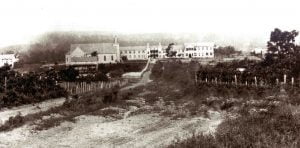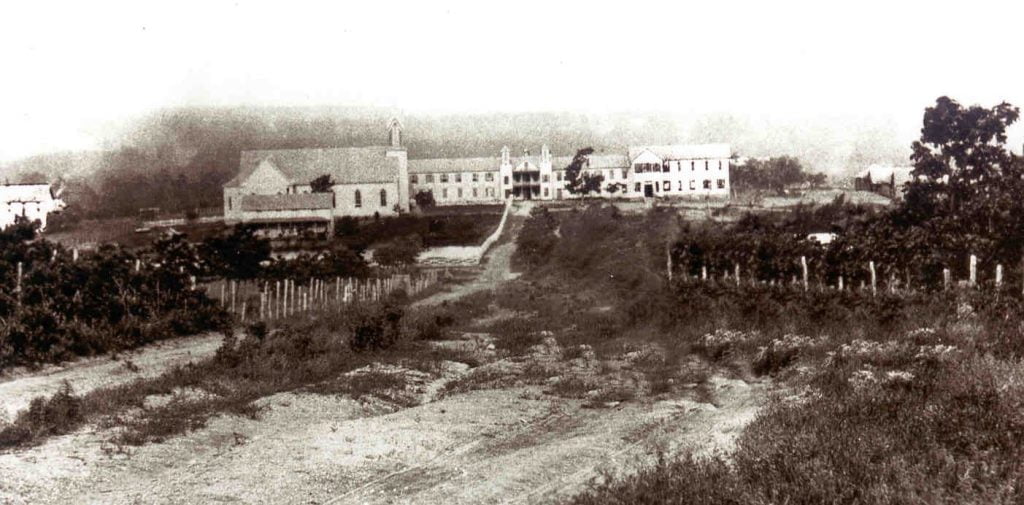When hearing of Konawa, many people immediately associate the town with the Sacred Heart Mission and Church, the cornerstone of Konawa history. Benedictine Father Matthew Brown is the present pastor of Sacred Heart. There are about 65 active families in the parish with a total number of about 150 people.
Sacred Heart is located in the southeast corner of Pottawatomie County in Oklahoma approximately 9 miles east of Asher and 4 miles northwest of Konawa and approximately 1 mile north of Oklahoma Highway 39 on Sacred Heart Road.
Catholics were among the first whites to enter the state and consider the Indian people as human beings. The Potawatomi Indians were among the first settlers in Indian Territory. They were almost all Catholics and without any religious ministration. Nevertheless, they were not forgotten by the Jesuit Fathers notably Father Maurice Gaillard, who in letters urged Father Isidore Robot to “consider ministering to the abandoned Indians”. He went to visit the newly migrated Potawatomi Nation of civilized Indians to confer with their leaders concerning the prospect of founding a mission and a school.

October of 1876, Father Robot concluded an arrangement with the Citizen Band Potawatomi Indians for a tribal grant of land including the site of Sacred Heart Mission. The place selected was the western end of Bald Hill. Pioneering Sacred Heart was a struggle. On Sunday, May 13, 1877, Father Felix celebrated the first Mass at Sacred Heart under the open sky to the delight of the Indians. Sacred Heart was not permanently occupied until June 7, 1977, on the eve of the Feast of Sacred Heart – when a contingent of Fathers came from Atoka. Perhaps they can be regarded as the true founders of the parish. Hence, the 125th anniversary celebration was this year, 2002. Work on the construction of the new Sacred Heart Monastery continued and by 1877 they had built the two-story building and novitiate as well as a school for Indian boys and a farm. Sacred Heart Monastery for many years was the center of Catholicism in the state. After the construction of the large building that was both monastery and school, Mass was celebrated in a chapel in this building.
In 1901, Father Robot was appointed by Rome as the first Perfect Apostolic of the Indian Territory. With Sacred Heart as headquarters, Father Robot went out to found some 40 parishes and missions. In 1880 the first nuns from New Orleans arrived to take on teaching duties at the mission. The five sisters recruited by Father Robot arrived at Sacred Heart on July 9, 1884, to staff the girls’ school. This started St. Mary’s Academy and Convent. In 1884 there was a convent for the Sisters, a school for the girls, stables, employees’ houses, blacksmith shop, tool house, carpenter shop, and of course, the bakery-where the sisters baked 500 big French loaves each day.
Meanwhile Sacred Heart Mission flourished and expanded. A complete monastic regime was inaugurated and an Indian day school for boys got underway. St. Benedict’s Industrial School at Sacred Heart, with both male and female boarders, was a government contract school for Indians until the late 1890s. Additionally, Sacred Heart included seminary and college-level studies. Factually, here was the first institution of higher learning in the present state of Oklahoma.
A model farm – with a great variety of orchards, gardens, vineyards, fields, herds of animals and every form of agriculture was developed during the ’80s. The farm had two main purposes: to supply food for the institution and to provide a model for the Indian boys to copy.
The mission had the Indian Advocate, its own publication, printed in the bakery building. Published from 1888 to 1910, it was a quarterly review, then a monthly magazine.
They were calling the mission Sacred Heart College because they were training people in the upper division for seminary. Sacred Heart College was a forerunner of our agricultural colleges and industrial schools in Oklahoma today plus the finer arts of music and painting. Sacred Heart College also boasted a chemical lab that was well equipped for its day, being installed shortly after the turn of the century. In Sacred Heart College, as today, the students were all required to study mathematics, English, business practice, and human relations.
Children of many tribes, as well as white children of ranchers and others who dwelt in the Indian country knew Sacred Heart as the center of Catholicism of the whole territory, having a school of importance, which was patronized.
On the night of January 15, 1901, came the disaster from which Sacred Heart never fully recovered. On a stormy night in January, a fire broke out in the dining room of the Indian Boys School and swept out of control. Before it was over the blaze had taken the monastery, boys’ school, college, girls’ school, convent, and the church. They were all gone within a few hours, the light from the fire could be seen from as far away as Purcell. The entire mission was destroyed with the exception of a few small buildings. The bakery and the two-story log cabin are the only buildings that remain today. Temporary wooden buildings were set up to carry on the boys’ school, while the Sisters of Mercy moved one-quarter of a mile southeast to create a new St. Mary’s Academy. So, Mass was celebrated in a converted granary. This building served the students and the Catholic people until the present church was completed in 1914.
Many of the Benedictine community, from the time of the fire, favored the development of an educational center elsewhere. By 1910, the Benedictines went on from Sacred Heart to build St. Gregory’s College in Shawnee, OK. A large Tudor-Gothic structure, the present administration building of St. Gregory’s College, was under construction by 1913, opening its doors for high school and college students for its first term in 1915. An elementary school for boys continued at Sacred Heart until 1926. Sacred Heart remains as their mother-house for many years, until its transfer to Mt. Saint Mary’s in OKC.
The Sisters of Mercy founded numerous educational and medical facilities across the state, including St. Mary’s Academy and Mercy Health Center in OKC.
With the transfer of the educational and monastic endeavors to St. Gregory’s College, a process, which was complete by the early 1930s, Sacred Heart’s day of activity and importance, was now finished. Prior to its destruction, the State Planning and Resources Board considered for a time the prospects of taking the offer of Sacred Heart Mission site as a unit in the state park system and aiding it in the preservation of this historic place.
The first cemetery used by the Potawatomi Indians was the one across the road in what came to be known as Zoeller’s pear orchard. There are a number of graves there – John Shopwattuck, Indian scout for the Union Army, for example. The south half of the present cemetery was known as the Protestant Cemetery, because the people of Maud had no cemetery of their own at that time and asked the Benedictine Fathers for space, which was granted to them. It was separated from the Catholic side by a fence.
The Fathers had their own cemetery next to the mission. A weathered, bronze plaque identifies the resting place of Father Isidore Robot, who founded the mission. The Sisters of Mercy had their cemetery about 100 feet south of the Father’s Cemetery. Both cemeteries are still in existence and are being maintained by the Sacred Heart Mission Historical Society volunteers.
Some talented and famous people have come from Sacred Heart. Oklahoma’s legendary athlete Jim Thorpe was educated at Sacred Heart. So was Patrick Hurley, a soldier and diplomat who served as U.S. Secretary of War from 1929-1933 and a later Ambassador to China in 1944-1945. Jim Thorpe, perhaps one of the most legendary athlete in modern history, was baptized November 19, 1887 by Father Thomas Duperou. Thorpe’s mother, Charlotte Vieux Thorpe, is buried under a cedar tree in the parish cemetery. Tony Hillerman, nationally acclaimed mystery writer, was baptized at Sacred Heart on June 7, 1925, 11 days after his birth. He grew up in the Sacred Heart area.
In 1987, a group of local parishioners banned together to stop the removal of the buildings to Shawnee and formed the Sacred Heart Mission Historical Society (SHMHS). The Historical Society volunteers continue their effort of restoring and maintaining the mission grounds with the help of the Potawatomi Indians and many others.



My people still live in the area and we have family buried in the parishioners cemetery. My aunt is a parishioner. I will see if I can get info through her.
Does anyone know where enrollment records at Sacred Heart Academy are kept. My mother and aunt attended there in the 1920s, possibly early 30s. I’d like to find what age they were while there.
Does anyone know who would have the burial records or old plot maps of the southern “Protestant” section of the Parishioner’s cemetery? My great grandmother, and her sister, are buried there. St. Gregory’s (not very helpful by the way!) owns Sacred Heart, they claim to not have anything on it. Thank you.
Anyone have any information on Dr. Charles Quinn who died in Allen, Indian Territory, on May 18, 1897? Possibly he was contracted to work for Sacred Heart in Konawa.
I saw a post that he was buried in the Allen cemetery in an unmarked grave but can’t confirm.